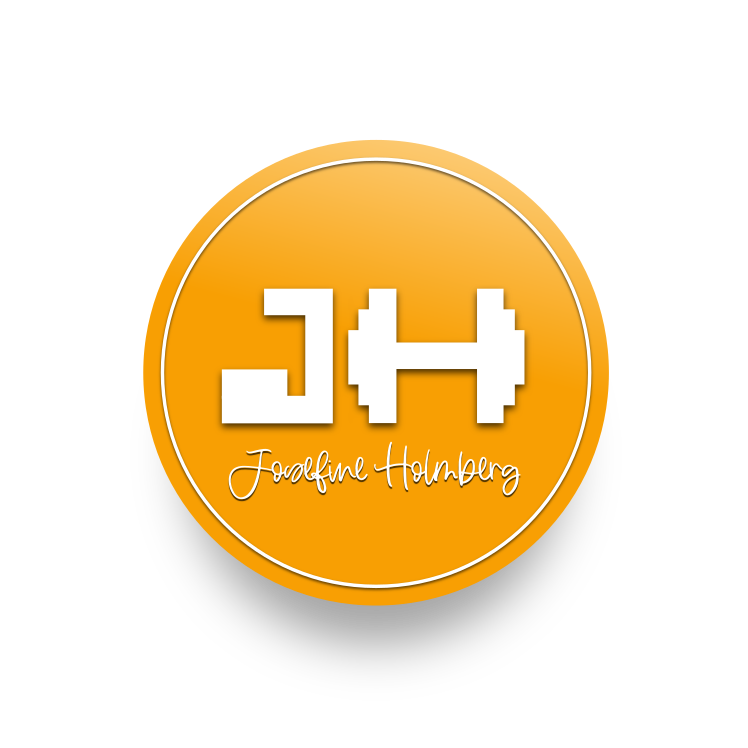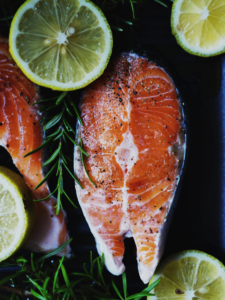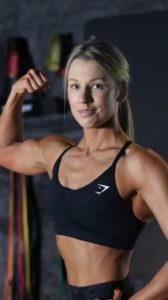Train Like A Woman
Even training is different for women compared to men due to our hormonal differences, so if you want results you not only have to eat like a woman you also need to train like a woman. So how do you train like a woman? You need to take the different phases in your menstrual cycle into consideration. Some weeks during the month will be harder and other weeks will be easier. For men their hormones are pretty stable during the entire month while women have changes throughout the month. I know, it’s unfair BUT if you are aware you can make changes in order to work with your hormones and your body instead of against it.
Train Like a Real Badass Woman – Josefine

Our two main phases
Follicular phase & Luteal phase are our two hormonal phases.
Follicular = Low Hormone Phase – During this phase we are similar to men in our carbohydrate metabolism and recovery.
Luteal = High Hormone Phase – this is the time when it’s all different. This is the time leading up to your period, estrogen and progesterone is high after ovulation and causes
– Fluids to shift into the cells, → Decreases your blood plasma volume, and makes you more predisposed to central nervous system fatigue, which makes exercise feel harder than usual.
During the high hormone phase, it is not your fitness, it is due to your physiology and in order to succeed you need to work with and not against your natural physiology.
How does all this affect training?
We have a two week period when our training will be a little bit compromised, during the high hormones, luteal, phase, and we can’t really push as hard as we would like to. This is once ovulation occurs and your levels of estrogen and progesterone increases.
What can we do about it?
First of all, nutrition is extremely important, we know that we need to stay on top of our hydration because progesterone and estrogen actually decrease the water in our blood. We can also think about adding a little more salt to our food and eating more watery veggies and fruits with some added salt throughout the day to increase the amount of water that actually is in our bodies available for sweating and for blood circulation.
Recovery is really important during this time. Our ability to build muscles during these two weeks is a little compromised because progesterone is very catabolic, so having a little bit of protein before and definitely after training knocks that progesterone aspect back and allows our muscles to recover and adapt. When you are exercising you put your body under stress, and you want your body to recover from this stress to get fitter and stronger. In order to do so you need to think about the following:
- About 10 grams of protein before training – this decreases the signal from the progesterone to break down muscle tissue because you have more amino acids circulating which help building muscles up and recover.
- You need 20-25 grams of a good protein source after training, preferably within a 30 minute window (women have a shorter recovery window than men). The fastest and most readily available protein source is whey protein and if you combine it with casein you will have amino acids circulating for a longer period of time which helps with muscle repair and adaptation.
- You have a recovery window of about 90 minutes so within the 90 minutes it is also critical to replace carbohydrates back into your liver and your muscles.
- Try to adjust your eating around your training in order to maximize your recovery and adaptation which will help you to get another great and hard session the next day!
The most critical days are the 5-7 days before your period, this is mid to late luteal phase and you will feel progressively worse and it’s normal. Progesterone and estrogen interplay to cause a bit of metabolic mayhem;
- A women’s core temperature is elevated about 0.5 celsius degrees.
- Sweating happens later. This means a woman gets hotter before she starts to sweat, which is why any high level intensity activity or activities in hot climate can feel harder during this period of time.
- Can’t access stored carbohydrate well, which makes it harder to hit intensity workouts well
- Estrogen and progesterone cross the blood-brain barrier, and increase central nervous system fatigue. This results in PMS – a lot of feelings and moodiness.
- In this phase – do more steady state/endurance focused work, bodyweight or lighter resistance training work – higher reps, lower weight)
Here are some things we can do to reduce PMS – If we think about how estrogen and progesterone affect our blood circulation and our metabolism, we want to increase our water and salt intake, increase our magnesium intake, and also increase our protein intake. All of these things help counteract the negative effects of progesterone and estrogen.
Resistance training
You must lift heavy things in order to develop shape in core, glutes, hamstrings, shoulders etc, maintain a lean physique and to gain strength. If you want an overall lean body and maximize your lean body mass strength training is extremely effective.
How can we build our training around our menstrual cycle?
Day 1 of bleeding leaning to ovulation – The low hormone phase
This is the best time to hit the gym and work strength and power. Your body is capable of lifting heavier and higher intensities because the progesterone and estrogen is low.
From ovulation to Day 1 of bleeding – The High hormone phase
This is when things get trickier, it becomes more challenging to lift heavy and keep high inteniestes and express power and you don’t recover as well because your fatigue is higher. In order to continue to develop strong, lean muscle this is a good time to follow a hypertrophy-type training style with higher reps, less intensity, you want to aim for 8-15 reps instead of the 2-5 rep range.
Lifting heavy at least three days per week will be very beneficial, resistance training is crucial in order to maintain lean body mass, bone mass, strength, neuromuscular activity and it helps to slow down the aging process. It will keep you healthier, stronger and fit for life.
In Summary
Low Hormone phase – focus on strength and power = Lower reps (3-8), higher weights, higher intensities
High Homeone phase – focus on hypertrophy = Higher reps, (8-15) lower weights, lower intensities
LOVE,
Josefine





